Polemics
 |
 |
 |
 |
 |
 |
 |
Divine Mercy Devotion - VI
Br. Theodore Roriz, O.C., Refutes
Michael Hichborn on Divine Mercy
Mr. Hichborn,
It has been brought to my attention that you published a defense of the Divine Mercy devotion in response to the sermon of Msgr. Patrick Perez.
In regards to the Divine Mercy I distinguish two things:
First, the revelations written by Sister Faustina Kowalska; second, the actual Divine Mercy devotion that was spread as a consequence of those revelations.
Regarding the first point, given the history of Divine Mercy (DM), the errors and bizarre eccentricities of Sr. Faustina and the circumstances under which the devotion was officially promulgated, it is entirely reasonable that a Catholic be opposed to it. Even without these reasons, let us not forget that the DM is just a private revelation.
 Regarding the second point, I have to say that this devotion induces persons to believe they are not supposed to fight against the consequences of original sin in themselves nor the bad influences of the world, nor the temptations of the Devil, but only trust in divine mercy. This trust would be sufficient to eradicate any bad action, tendency or influence and deliver the man to eternal salvation. (Sister Faustina’s Diary entries 699, 1074, 1485, 1578)
Regarding the second point, I have to say that this devotion induces persons to believe they are not supposed to fight against the consequences of original sin in themselves nor the bad influences of the world, nor the temptations of the Devil, but only trust in divine mercy. This trust would be sufficient to eradicate any bad action, tendency or influence and deliver the man to eternal salvation. (Sister Faustina’s Diary entries 699, 1074, 1485, 1578)
This is a re-edition of Miguel de Molinos’ heresy of Quietism, which says that man does not need to do anything to be saved but must simply entrust himself entirely to God to let grace act in him. (Denzinger 1224, 1237, 1238, 1257)
Although this is a wrong orientation, I acknowledge that many individuals who practice the Divine Mercy devotion are doing so moved by an honest intention and may receive graces from it.
Despite this, since you have taken it upon yourself to attack the position held by Msgr. Perez and defend DM and its devotion, I attack your position.
Your defense of DM in response to Msgr. Perez falls short in several key aspects. I list your arguments in sequential order, with my responses listed accordingly.
Argument 1- You argue that the devotion has not been condemned, rather it was merely put on the Index of Forbidden Books.
It seems to me that you are playing with words. Twice the Holy Office issued statements against Sr. Faustina and the Divine Mercy devotion. Taken together, these statements from the Holy Office forbade the dissemination of the works and devotions of Sr. Faustina, forbade that the Divine Mercy Sunday (a tenet central to her devotions) be instituted, and tasked individual Bishops to prudently remove images associated with DM.
Furthermore, the first Holy Office decree on the matter (1958) established that the revelations to Sr. Faustina are not of an assuredly divine origin as they claimed to be.
If the ensemble of these measures is not a condemnation, then this word has lost its meaning.
For reference, the two statements of the Holy Office are as follows:
November 19, 1958: Plenary Meeting of the Divine Office
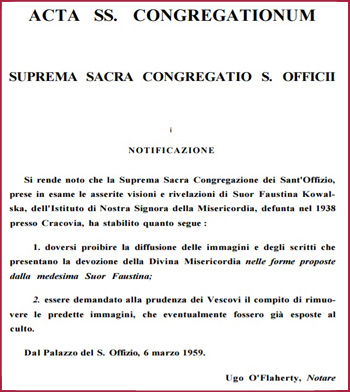
Consequently, your first argument is false and you mislead your audience when you say the opposite.
Argument 2 - You argue that the same Pope Pius XII who condemned DM had blessed a DM image earlier in 1956 and that this somehow justifies the devotion.
If this blessing had occurred after the condemnation, it might carry force. However, under the circumstances the Pope blessed an image before the censure, and, only afterward, issued the condemnation. This means that he either did not know that the image he blessed was related to Sr. Faustina’s DM or that he changed his mind and forbade it.
Therefore, your second argument is also false.
Argument 3 - You argue that John XXIII did not condemn DM, but rather the Holy Office forbade its circulation, and that this does not amount to a condemnation.
Here you repeat a sophism analogous to that in your first argument. Instead of playing with words, now you are playing with the roles of the Pope and the Holy Office.
 The Holy Office was, until the reforms coming from Vatican II, the official organ of the Pope to speak on doctrinal matters. It carried the weight of papal authority. So, there was no need to have two condemnations, one of the Holy Office and another of the Pope as you imply. The condemnation of the Holy Office effectively operates as a papal condemnation.
The Holy Office was, until the reforms coming from Vatican II, the official organ of the Pope to speak on doctrinal matters. It carried the weight of papal authority. So, there was no need to have two condemnations, one of the Holy Office and another of the Pope as you imply. The condemnation of the Holy Office effectively operates as a papal condemnation.
This sophism is akin to claiming that when a minister of defense enters war, it is only he that does so and not the President of the country. Instead, the minister of defense enters war because the President ordered him to do so. The decision of one implies that of the other.
Hence, the Holy Office spoke with papal authority.
Argument 3 is, therefore, false and it misleads your readers.
By playing with words and roles for the second time, you reveal yourself to be tricky and dishonest.
Argument 4 - You insist that suppression of DM is not the same as condemnation.
As I mentioned in my response to Argument 1, forbidding circulation of Sr. Faustina’s writings, forbidding the institution of Divine Mercy Sunday, enjoining bishops to remove images of the Divine Mercy devotion and placing her works on the Index Librorum Prohibitorum are explicit condemnations.
Argument 5 - You state that the reason behind the original suppression of DM was a poor translation that misrepresented Sr. Faustina, her writings and the devotion.
In the two statements released by the Holy Office the condemnations are general, not specific. There is no particular point of the DM or the writings of Sr. Faustina that are cited, meaning that a mistranslation of this or that paragraph has no bearing. They were condemned as a whole.
 If the Holy Office had listed specific parts of Sr. Faustina’s works that were questionable and these parts were later shown to be mistranslated, then a revocation of these parts would be understandable. But, this did not happen. No specific text was used in those verdicts.
If the Holy Office had listed specific parts of Sr. Faustina’s works that were questionable and these parts were later shown to be mistranslated, then a revocation of these parts would be understandable. But, this did not happen. No specific text was used in those verdicts.
Therefore, the argument that the revelations upon which the Holy Office based itself were mistranslated is irrelevant.
I will deal with this subject – mistranslations – more at length in argument 8.
Argument 6 - You raise the point that Sr. Faustina predicted the condemnation of DM and the eventually lifting of this condemnation and you use this to justify the veracity of those revelations.
The Devil can also offer highly accurate predictions of the future, and if her visions were false and inspired by the Devil, then a demonic prediction that turned out to be true would have the same appearance as if it were a revelation from God.
Therefore, your argument that the prophecies of Sr. Faustina prove the veracity of her revelations is inconclusive.
Furthermore, several of her “prophecies” completely failed to materialize as can be seen here.
Argument 7 - You say that the condemnation was officially lifted some time after the original documents were studied and the cause of concern ended after the mistranslations were corrected.
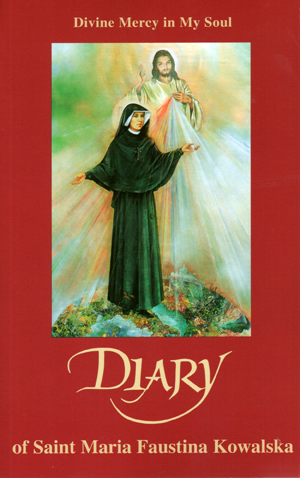 I divide this argument into two parts: The first, which I will address in this response, is: The meaning of the texts changed because of errors in the translation;
I divide this argument into two parts: The first, which I will address in this response, is: The meaning of the texts changed because of errors in the translation;
The second, which I will address in my response to Argument 8, is: The condemnations were officially lifted.
I have on hand a list of the more important mistranslations of the original Diary of Sr. Faustina which was one of the documents the Vatican examined. I also have a copy of her Diary that has been translated correctly.
Here are but a few of the questionable entries from the Diary of Sr. Faustina (“Divine Mercy in My Soul,” Stockbridge MA: Marian Press, 1987). The following passages are up-to-date entries, properly translated and endorsed by the modern advocates of DM.
You are using the mistranslations as a red herring to distract from the dubious diary content.
For a more comprehensive list of errors, points of concerns and outright contradictions in Sr. Faustina’s journals, see here
Argument 8 - You say that Card. Alfredo Ottaviani, the one behind the original condemnations, assigned Archbishop Karol Wojtyla to study the case of Sr. Faustina, and that this led to the discovery of the mistranslations, interviews with the fellow sisters and the spiritual director of Sr. Faustina and, ultimately, to the reversal of the condemnation. You argue that if Card. Ottaviani, the original enemy of DM, changed his mind and worked to redeem the devotion it reveals that the original problem was simply an error that can be dismissed.
First, Card. Ottaviani did not initiate a re-investigation into Sr. Faustina’s case; he merely permitted then-Archbishop Karol Wojtyla to head an investigation at the request of Wojtyla himself. Archbishop Wojtyla, like many Poles, had already developed a deep affection for Sr. Faustina and her devotion prior to the condemnations of 1958 and 1959. Thus, in 1965, Wojtyla asked for and received permission to gather testimonies and open another informative process on her life.
 Second, with this permission, Wojtyla and his assistants set about the task of justifying the devotion and lifting those condemnations. The devotion, in many ways, reflected a theological view that closely followed the line of their own progressivist inclinations. One of the priests investigating under Wojtyla went so far as to proclaim the Divine Mercy devotion a “second baptism.” It was this same team that raised the question of mistranslations as the cause for the Holy Office condemnation.
Second, with this permission, Wojtyla and his assistants set about the task of justifying the devotion and lifting those condemnations. The devotion, in many ways, reflected a theological view that closely followed the line of their own progressivist inclinations. One of the priests investigating under Wojtyla went so far as to proclaim the Divine Mercy devotion a “second baptism.” It was this same team that raised the question of mistranslations as the cause for the Holy Office condemnation.
Third, despite the overwhelmingly favorable view of DM presented by Wojtyla and his fellow progressivists, the condemnation remained in force for 13 more years until April 1978 (long after the Holy Office and the Index of Forbidden Books had ceased to exist).
It was only after the question was raised about whether the condemnation was still in force that in 1978 – in the last months of Paul VI pontificate – the Congregation for the Doctrine of the Faith declared the censure of its predecessor (the Holy Office) void, citing as reasons “the opinion of many Polish Ordinaries” – that is, Wojtyla and his adepts – as well as the vague excuse of “changed circumstances.”
What we have, then, is a situation where Archbishop Wojtyla spearheaded an investigation of one of his favorite devotions and, then, worked to lift the condemnation. As John Paul II, he would establish the Divine Mercy Sunday as an official feast day in the liturgy of the Novus Ordo, beatify Sr. Faustina and, later, even declare her a saint. So great was his personal attachment to DM that he described its propagation as “my special task.” (1)
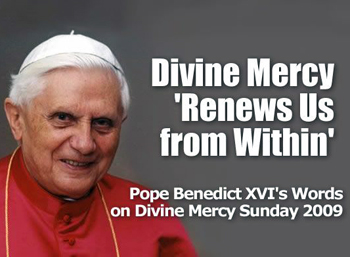
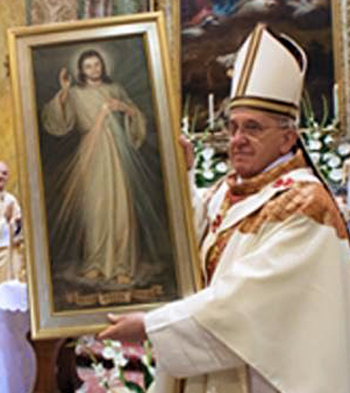 Fourth, in summary we find that under Pius XII and John XXIII the devotion was condemned. Under Paul VI the condemnation was lifted, while under JP II the devotion was not only approved, but it was highly promoted by the Pope, who also beatified and canonized Sr. Faustina.
Fourth, in summary we find that under Pius XII and John XXIII the devotion was condemned. Under Paul VI the condemnation was lifted, while under JP II the devotion was not only approved, but it was highly promoted by the Pope, who also beatified and canonized Sr. Faustina.
Fifth, I affirm: This contradiction between Popes can be explained by a colossal historical event: Vatican II. There is a contradiction between the Church’s doctrine before those condemnations and the one after them. Under Pius XII and John XXIII the Catholic doctrine was the same that the Church had always professed. Then, Vatican II came and changed it to a completely different doctrine. It was because Paul VI and John Paul II were following this new conciliar doctrine that they changed the position of the Church on DM and approved it.
Thus, what surfaces here is that you are trying to cover for this contradiction and avoid admitting this difference of doctrine by presenting many baseless arguments.
Argument 9 - You argue that if the condemnations from the Holy Office were actually doctrinal, then the re-investigation into Sr. Faustina’s life would not have been permitted. In other words your argument is: If those condemnations were definitive there would be no possibility of starting a new investigation.
The argument would be valid if the Church would not have suffered the Conciliar Revolution during the time between its condemnations of 1958 -1959 and its approvals in 1978. However, during this period Catholic doctrine completely changed and was replaced with Progressivism.
I affirm that what made Paul VI lift the previous condemnations of DM and led John Paul II to promote it was not any mistake or misunderstanding of the Holy Office, but a change in the orientation of the doctrine. What was right before, became wrong afterwards, and vice-versa.
Therefore, the point in question switches to a much broader subject. It is this: The writings of Sr. Faustina were approved by John Paul II because Divine Mercy favors the wrong spirituality and lax morality of Progressivism.
Argument 10 - You say that as much as John XXIII was at fault for failing to release the 3rd secret of Fatima, so also was he mistaken when he condemned DM.
In this argument you ignore that the studies that led to the condemnations of DM started during the pontificate of Pius XII. This is easy to confirm by a comparison of dates. Pius XII died on October 9, 1958, and the first condemnation was issued in November 19, 1958, only 40 days after his death, which indicates that they were prepared under his papacy. Only the second condemnation can be attributed exclusively to John XXIII, since it was issued in 1959.
Therefore, there were two Popes involved in those condemnations and not exclusively John XXIII, as you imply.
Furthermore, for this discussion it is irrelevant that John XXIII made the mistake of failing to release the Third Secret. A Pope’s failure in one area does not necessarily indicate a failure in another.
Argument 11- You argue that it is dishonest to present the suppression of DM as a condemnation and ignore that the Church has approved and institutionalized the DM since 1978.
The two actions, the condemnations and the approval, were contradictory actions under Popes following contradictory doctrines, as mentioned. Popes Pius XII and John XXIII condemned DM and Popes Paul VI and John Paul II approved it.
So, according to you, anyone who presents only one side as being the thinking of the Church and does not harmonize it with the other side is dishonest.
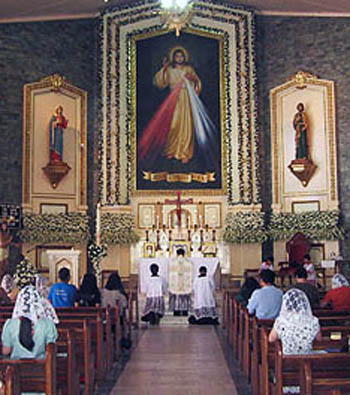 Let me analyze this reasoning.
Let me analyze this reasoning.
The article of Msgr. Perez did not address the clear contradiction of the two actions because that article was actually the transcript of a sermon he delivered to the traditionalist audience of his chapel, as explained in the introductory note to that TIA article. This audience is aware ad nauseam that Vatican II changed the doctrine of the Church and, thus, did not need such an explanation. So, his aim was simply to inform his parishioners that DM had been condemned before Vatican II because some of his parishioners were asking to introduce some of DM practices into his chapel.
There is nothing dishonest in this procedure. It is what a good priest is supposed to do for the good of souls. Nor is there anything dishonest in TIA publishing that article against DM for its audience, because TIA also clearly takes a critical position on Vatican II, as is obvious to anyone who browses our website.
What would be dishonest is if someone were to try to show the approval of DM as an official position of the Church while trying to hide that there was an enormous change in doctrine between those condemnations (1958-1959) and the beginning of the pontificate of John Paul II (1978). This person would be trying to present Vatican II and its fruits, including DM, in perfect continuity with the tradition of the Church. This would be dishonest because it would be covering for the errors of Progressivism.
This is what you did.
Therefore, the dishonesty was not in Msgr. Perez’ position, but in yours.
Conclusion
Sr. Faustina’s works became popular after her death but were condemned by two decrees of the Holy Office. Her Divine Mercy Sunday was forbidden to be instituted, her works were forbidden to be divulged or distributed, and Bishops were required to remove images of this devotion following prudent measures.
Later, one of her personal devotees, the progressivist Archbishop Wojtyla, came forward and requested that he be allowed to gather more information about her. Permission was granted and – lo and behold – “mistranslations” were blamed for her previous condemnations. Through the efforts of Wojtyla, the condemnations were reversed.
Then, as Pope John Paul II, Wojtyla established Divine Mercy as an official Feast Day in the liturgy of the Church, promoted Sr. Faustina to the dignity of a saint and even consecrated the world to Divine Mercy in 2002. The very serious suspicions that prompted the previous condemnations were dismissed as fruits of nothing more than “bad translations.” All the other grave reservations were swept aside in order to promote a devotion that aligns perfectly with the ideals of Progressivism.
The defenders of Divine Mercy try to impose it on the faithful in the name of papal authority. They cunningly avoid saying that Vatican II changed Catholic doctrine and that, therefore, today we have Conciliar Popes opposing pre-Vatican II Popes.
The right thing to do is to face the contradiction and analyze the opposition of these doctrines: the perennial Catholic doctrine and the progressivist post-Conciliar doctrine.
This is what I have to observe on your attack against Msgr. Patrick Perez' position on Divine Mercy.
In Jesu et Maria,
Br. Theodore Roriz, O.C.

It has been brought to my attention that you published a defense of the Divine Mercy devotion in response to the sermon of Msgr. Patrick Perez.
In regards to the Divine Mercy I distinguish two things:
First, the revelations written by Sister Faustina Kowalska; second, the actual Divine Mercy devotion that was spread as a consequence of those revelations.
Regarding the first point, given the history of Divine Mercy (DM), the errors and bizarre eccentricities of Sr. Faustina and the circumstances under which the devotion was officially promulgated, it is entirely reasonable that a Catholic be opposed to it. Even without these reasons, let us not forget that the DM is just a private revelation.

Molinos publicly professed Quietism & spent the rest of his life in prison
This is a re-edition of Miguel de Molinos’ heresy of Quietism, which says that man does not need to do anything to be saved but must simply entrust himself entirely to God to let grace act in him. (Denzinger 1224, 1237, 1238, 1257)
Although this is a wrong orientation, I acknowledge that many individuals who practice the Divine Mercy devotion are doing so moved by an honest intention and may receive graces from it.
Despite this, since you have taken it upon yourself to attack the position held by Msgr. Perez and defend DM and its devotion, I attack your position.
Your defense of DM in response to Msgr. Perez falls short in several key aspects. I list your arguments in sequential order, with my responses listed accordingly.
Argument 1- You argue that the devotion has not been condemned, rather it was merely put on the Index of Forbidden Books.
It seems to me that you are playing with words. Twice the Holy Office issued statements against Sr. Faustina and the Divine Mercy devotion. Taken together, these statements from the Holy Office forbade the dissemination of the works and devotions of Sr. Faustina, forbade that the Divine Mercy Sunday (a tenet central to her devotions) be instituted, and tasked individual Bishops to prudently remove images associated with DM.
Furthermore, the first Holy Office decree on the matter (1958) established that the revelations to Sr. Faustina are not of an assuredly divine origin as they claimed to be.
If the ensemble of these measures is not a condemnation, then this word has lost its meaning.
For reference, the two statements of the Holy Office are as follows:
November 19, 1958: Plenary Meeting of the Divine Office

1959 reiteration of the condemnation
- The supernatural nature of the revelations made to Sr. Faustina is not evident.
- No feast of Divine Mercy is to be instituted.
- It is forbidden to divulge images and writings that propagate this devotion under the form received by Sr. Faustina.
- The diffusion of images and writings promoting the devotion to Divine Mercy under the form proposed by the same Sr. Faustina was forbidden.
- It is left to the prudence of the bishops to judge as to the removal of the aforesaid images that are already displayed for public honor.
Consequently, your first argument is false and you mislead your audience when you say the opposite.
Argument 2 - You argue that the same Pope Pius XII who condemned DM had blessed a DM image earlier in 1956 and that this somehow justifies the devotion.
If this blessing had occurred after the condemnation, it might carry force. However, under the circumstances the Pope blessed an image before the censure, and, only afterward, issued the condemnation. This means that he either did not know that the image he blessed was related to Sr. Faustina’s DM or that he changed his mind and forbade it.
Therefore, your second argument is also false.
Argument 3 - You argue that John XXIII did not condemn DM, but rather the Holy Office forbade its circulation, and that this does not amount to a condemnation.
Here you repeat a sophism analogous to that in your first argument. Instead of playing with words, now you are playing with the roles of the Pope and the Holy Office.

The progressivist and moral-free JPII is indissociable from the Divine Mercy devotion
This sophism is akin to claiming that when a minister of defense enters war, it is only he that does so and not the President of the country. Instead, the minister of defense enters war because the President ordered him to do so. The decision of one implies that of the other.
Hence, the Holy Office spoke with papal authority.
Argument 3 is, therefore, false and it misleads your readers.
By playing with words and roles for the second time, you reveal yourself to be tricky and dishonest.
Argument 4 - You insist that suppression of DM is not the same as condemnation.
As I mentioned in my response to Argument 1, forbidding circulation of Sr. Faustina’s writings, forbidding the institution of Divine Mercy Sunday, enjoining bishops to remove images of the Divine Mercy devotion and placing her works on the Index Librorum Prohibitorum are explicit condemnations.
Argument 5 - You state that the reason behind the original suppression of DM was a poor translation that misrepresented Sr. Faustina, her writings and the devotion.
In the two statements released by the Holy Office the condemnations are general, not specific. There is no particular point of the DM or the writings of Sr. Faustina that are cited, meaning that a mistranslation of this or that paragraph has no bearing. They were condemned as a whole.

JPII's victories: Divine Mercy approval and Sr. Faustina's canonization
Therefore, the argument that the revelations upon which the Holy Office based itself were mistranslated is irrelevant.
I will deal with this subject – mistranslations – more at length in argument 8.
Argument 6 - You raise the point that Sr. Faustina predicted the condemnation of DM and the eventually lifting of this condemnation and you use this to justify the veracity of those revelations.
The Devil can also offer highly accurate predictions of the future, and if her visions were false and inspired by the Devil, then a demonic prediction that turned out to be true would have the same appearance as if it were a revelation from God.
Therefore, your argument that the prophecies of Sr. Faustina prove the veracity of her revelations is inconclusive.
Furthermore, several of her “prophecies” completely failed to materialize as can be seen here.
Argument 7 - You say that the condemnation was officially lifted some time after the original documents were studied and the cause of concern ended after the mistranslations were corrected.

Objectionable lines even in the 're-translated' Diary
The second, which I will address in my response to Argument 8, is: The condemnations were officially lifted.
I have on hand a list of the more important mistranslations of the original Diary of Sr. Faustina which was one of the documents the Vatican examined. I also have a copy of her Diary that has been translated correctly.
Here are but a few of the questionable entries from the Diary of Sr. Faustina (“Divine Mercy in My Soul,” Stockbridge MA: Marian Press, 1987). The following passages are up-to-date entries, properly translated and endorsed by the modern advocates of DM.
- In entry 374 of her journal the alleged apparition of Our Lord says to Sr. Faustina: “From today on, do not fear God’s judgment, for you will not be judged.” The Final Judgment, let alone the personal judgment, is one of the most widely proclaimed Truths of the Catholic Faith. Our Lord will judge everyone - “the living and the dead.” Would Sr. Faustina be an exception to this rule? I don’t believe so.
- In entry 587, Our Lord says: “My daughter, if you wish, I will this instant create a new world, more beautiful than this one, and you will live there for the rest of your life.” Such an affirmation sounds more like a manifestation of a delirious egocentrism than a true revelation. How can any sane person imagine Our Lord is promising her that he will make a new world just for her, when He did not offer this to anyone else, not even to His Blessed Mother? Sr. Faustina here places herself above Most Holy Mary, which is an absurd pretension.
- Entry 707, Jesus says: “That is why I am uniting myself with you so intimately as with no other creature.” Here again Sr. Faustina believes herself more united with God than the Blessed Virgin Mary, who had the highest possible union with Him when she was generating Him in her womb. Again, it is a delirious egocentrism. I note that while Msgr. Perez raised concerns over this potentially heretical statement, you neglected to address this point in your rebuttal.
- Entry 1061, Our Lord says: “Beloved pearl of My heart, I see your love so pure, purer than that of the angels, and all the more so because you keep fighting.” This text as well as the others, sound more like the passionate declaration of a carnal lover than the words of Our Lord. There is no objectivity in the words; they are exaggerations that are not meant to be true, but just to express sentiments: “I am mad with love for you, I lost my senses because of you.” This declaration, which could be very flattering to a worldly nun, has no place coming from the mouth of Our Lord Jesus Christ, Who is Wisdom Incarnate.
You are using the mistranslations as a red herring to distract from the dubious diary content.
For a more comprehensive list of errors, points of concerns and outright contradictions in Sr. Faustina’s journals, see here
Argument 8 - You say that Card. Alfredo Ottaviani, the one behind the original condemnations, assigned Archbishop Karol Wojtyla to study the case of Sr. Faustina, and that this led to the discovery of the mistranslations, interviews with the fellow sisters and the spiritual director of Sr. Faustina and, ultimately, to the reversal of the condemnation. You argue that if Card. Ottaviani, the original enemy of DM, changed his mind and worked to redeem the devotion it reveals that the original problem was simply an error that can be dismissed.
First, Card. Ottaviani did not initiate a re-investigation into Sr. Faustina’s case; he merely permitted then-Archbishop Karol Wojtyla to head an investigation at the request of Wojtyla himself. Archbishop Wojtyla, like many Poles, had already developed a deep affection for Sr. Faustina and her devotion prior to the condemnations of 1958 and 1959. Thus, in 1965, Wojtyla asked for and received permission to gather testimonies and open another informative process on her life.

Introduced by JPII into the Novus Ordo calendar
Third, despite the overwhelmingly favorable view of DM presented by Wojtyla and his fellow progressivists, the condemnation remained in force for 13 more years until April 1978 (long after the Holy Office and the Index of Forbidden Books had ceased to exist).
It was only after the question was raised about whether the condemnation was still in force that in 1978 – in the last months of Paul VI pontificate – the Congregation for the Doctrine of the Faith declared the censure of its predecessor (the Holy Office) void, citing as reasons “the opinion of many Polish Ordinaries” – that is, Wojtyla and his adepts – as well as the vague excuse of “changed circumstances.”
What we have, then, is a situation where Archbishop Wojtyla spearheaded an investigation of one of his favorite devotions and, then, worked to lift the condemnation. As John Paul II, he would establish the Divine Mercy Sunday as an official feast day in the liturgy of the Novus Ordo, beatify Sr. Faustina and, later, even declare her a saint. So great was his personal attachment to DM that he described its propagation as “my special task.” (1)

Benedict XVI and Francis I enthusiastically promote the Divine Mercy devotion

Fifth, I affirm: This contradiction between Popes can be explained by a colossal historical event: Vatican II. There is a contradiction between the Church’s doctrine before those condemnations and the one after them. Under Pius XII and John XXIII the Catholic doctrine was the same that the Church had always professed. Then, Vatican II came and changed it to a completely different doctrine. It was because Paul VI and John Paul II were following this new conciliar doctrine that they changed the position of the Church on DM and approved it.
Thus, what surfaces here is that you are trying to cover for this contradiction and avoid admitting this difference of doctrine by presenting many baseless arguments.
Argument 9 - You argue that if the condemnations from the Holy Office were actually doctrinal, then the re-investigation into Sr. Faustina’s life would not have been permitted. In other words your argument is: If those condemnations were definitive there would be no possibility of starting a new investigation.
The argument would be valid if the Church would not have suffered the Conciliar Revolution during the time between its condemnations of 1958 -1959 and its approvals in 1978. However, during this period Catholic doctrine completely changed and was replaced with Progressivism.
I affirm that what made Paul VI lift the previous condemnations of DM and led John Paul II to promote it was not any mistake or misunderstanding of the Holy Office, but a change in the orientation of the doctrine. What was right before, became wrong afterwards, and vice-versa.
Therefore, the point in question switches to a much broader subject. It is this: The writings of Sr. Faustina were approved by John Paul II because Divine Mercy favors the wrong spirituality and lax morality of Progressivism.
Argument 10 - You say that as much as John XXIII was at fault for failing to release the 3rd secret of Fatima, so also was he mistaken when he condemned DM.
In this argument you ignore that the studies that led to the condemnations of DM started during the pontificate of Pius XII. This is easy to confirm by a comparison of dates. Pius XII died on October 9, 1958, and the first condemnation was issued in November 19, 1958, only 40 days after his death, which indicates that they were prepared under his papacy. Only the second condemnation can be attributed exclusively to John XXIII, since it was issued in 1959.
Therefore, there were two Popes involved in those condemnations and not exclusively John XXIII, as you imply.
Furthermore, for this discussion it is irrelevant that John XXIII made the mistake of failing to release the Third Secret. A Pope’s failure in one area does not necessarily indicate a failure in another.
Argument 11- You argue that it is dishonest to present the suppression of DM as a condemnation and ignore that the Church has approved and institutionalized the DM since 1978.
The two actions, the condemnations and the approval, were contradictory actions under Popes following contradictory doctrines, as mentioned. Popes Pius XII and John XXIII condemned DM and Popes Paul VI and John Paul II approved it.
So, according to you, anyone who presents only one side as being the thinking of the Church and does not harmonize it with the other side is dishonest.

Even communities with Latin Mass are taking up the Divine Mercy devotion - despite the contradictions
The article of Msgr. Perez did not address the clear contradiction of the two actions because that article was actually the transcript of a sermon he delivered to the traditionalist audience of his chapel, as explained in the introductory note to that TIA article. This audience is aware ad nauseam that Vatican II changed the doctrine of the Church and, thus, did not need such an explanation. So, his aim was simply to inform his parishioners that DM had been condemned before Vatican II because some of his parishioners were asking to introduce some of DM practices into his chapel.
There is nothing dishonest in this procedure. It is what a good priest is supposed to do for the good of souls. Nor is there anything dishonest in TIA publishing that article against DM for its audience, because TIA also clearly takes a critical position on Vatican II, as is obvious to anyone who browses our website.
What would be dishonest is if someone were to try to show the approval of DM as an official position of the Church while trying to hide that there was an enormous change in doctrine between those condemnations (1958-1959) and the beginning of the pontificate of John Paul II (1978). This person would be trying to present Vatican II and its fruits, including DM, in perfect continuity with the tradition of the Church. This would be dishonest because it would be covering for the errors of Progressivism.
This is what you did.
Therefore, the dishonesty was not in Msgr. Perez’ position, but in yours.
Conclusion
Sr. Faustina’s works became popular after her death but were condemned by two decrees of the Holy Office. Her Divine Mercy Sunday was forbidden to be instituted, her works were forbidden to be divulged or distributed, and Bishops were required to remove images of this devotion following prudent measures.
Later, one of her personal devotees, the progressivist Archbishop Wojtyla, came forward and requested that he be allowed to gather more information about her. Permission was granted and – lo and behold – “mistranslations” were blamed for her previous condemnations. Through the efforts of Wojtyla, the condemnations were reversed.
Then, as Pope John Paul II, Wojtyla established Divine Mercy as an official Feast Day in the liturgy of the Church, promoted Sr. Faustina to the dignity of a saint and even consecrated the world to Divine Mercy in 2002. The very serious suspicions that prompted the previous condemnations were dismissed as fruits of nothing more than “bad translations.” All the other grave reservations were swept aside in order to promote a devotion that aligns perfectly with the ideals of Progressivism.
The defenders of Divine Mercy try to impose it on the faithful in the name of papal authority. They cunningly avoid saying that Vatican II changed Catholic doctrine and that, therefore, today we have Conciliar Popes opposing pre-Vatican II Popes.
The right thing to do is to face the contradiction and analyze the opposition of these doctrines: the perennial Catholic doctrine and the progressivist post-Conciliar doctrine.
This is what I have to observe on your attack against Msgr. Patrick Perez' position on Divine Mercy.
In Jesu et Maria,
Br. Theodore Roriz, O.C.
- Wojtyla’s personal attachment to DM as the cause for the lifting of the condemnations is not just my opinion. In an issue dated August 30, 2002, National Catholic Reporter journalist John Allen Jr. observes: “Officially the 20-year ban is now attributed to misunderstandings created by a faulty Italian translation of the Diary, but in fact there were serious theological reservations.” In that same issue, a professor in Rome criticized Pope John Paul II’s devotion to DM by saying “the Church is not the Pope’s private sandbox.”

Posted June 7, 2017
______________________
______________________
 Volume I |
 Volume II |
 Volume III |
 Volume IV |
 Volume V |
 Volume VI |
 Volume VII |
 Volume VIII |
 Volume IX |
 Volume X |
 Volume XI |
 Special Edition |


